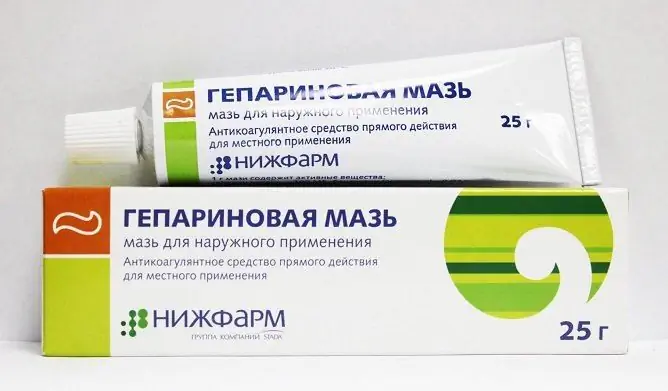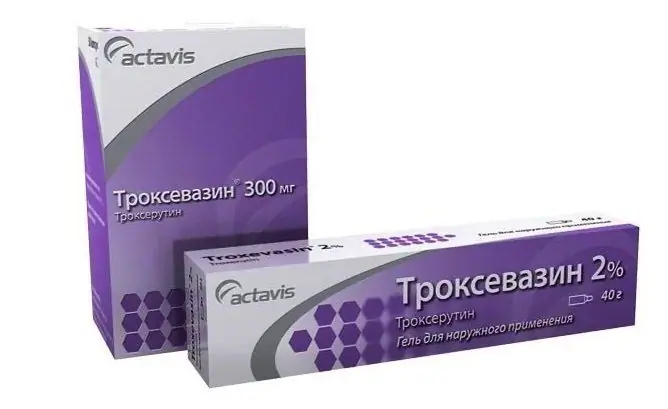- Author Rachel Wainwright [email protected].
- Public 2023-12-15 07:39.
- Last modified 2025-11-02 20:14.
Utrozhestan
Utrozhestan: instructions for use and reviews
- 1. Release form and composition
- 2. Pharmacological properties
- 3. Indications for use
- 4. Contraindications
- 5. Method of application and dosage
- 6. Side effects
- 7. Overdose
- 8. Special instructions
- 9. Application during pregnancy and lactation
- 10. Use in childhood
- 11. In case of impaired renal function
- 12. For violations of liver function
- 13. Drug interactions
- 14. Analogs
- 15. Terms and conditions of storage
- 16. Terms of dispensing from pharmacies
- 17. Reviews
- 18. Price in pharmacies
Latin name: Utrogectan
ATX code: G03DA04
Active ingredient: progesterone (progesterone)
Producer: Cyndea Pharma SL (Spain); OLIC (Thailand) Limited [OLIC (Thailand) Limited] (Thailand)
Description and photo updated: 2018-26-11
Prices in pharmacies: from 270 rubles.
Buy

Utrozhestan is a gestagenic agent used for disorders caused by progesterone deficiency.
Release form and composition
Utrozhestan is produced in the form of capsules: with a shiny surface, soft gelatinous, yellowish, oval (200 mg) or round (100 mg); contents - oily homogeneous whitish suspension without clear phase separation (dosage 100 mg - 14 pcs. in a blister, 200 mg - 7 pcs. in a blister; in a cardboard box 2 blisters).
1 capsule contains:
- active substance: micronized progesterone - 100 or 200 mg;
- additional components: soy lecithin, sunflower oil;
- shell: glycerol, gelatin, titanium dioxide.
Pharmacological properties
Pharmacodynamics
Progesterone, the active substance of Utrozhestan, is identical to the natural hormone produced by the corpus luteum of the ovary. After binding to receptors on the surface of cell membranes of target organs, it penetrates into the cell nucleus and, activating DNA, accelerates the production of RNA. The substance causes the transition of the endometrium (the mucous membrane lining the uterine cavity) from the proliferation phase, initiated by the follicular hormone estradiol, to the secretory phase, and after the fertilization of the egg, to the state that is necessary for its normal development.
Utrozhestan helps to reduce the contractility and excitability of the muscles of the fallopian tubes and uterus, as well as the formation of a normal endometrium. It activates the development of the terminal chambers of the mammary gland and induces lactation, provides an increase in fat reserves by stimulating the enzyme protein lipase. Utrozhestan improves glucose utilization and leads to the accumulation of glycogen in the liver by promoting an increase in the concentration of stimulated and basal insulin. Due to the influence of the gestagenic agent, the production of gonadotropic hormones of the pituitary gland increases, azotemia decreases, and the excretion of nitrogen by the kidneys increases.
Pharmacokinetics
Oral intake
Micronized progesterone is characterized by rapid absorption from the gastrointestinal tract (GIT). In the blood plasma, the level of progesterone gradually increases during the first hour after ingestion, and the maximum concentration (C max) of the substance is achieved after 1-3 hours. After administration, the level of the substance in the plasma increases from the reading of 0.13 ng / ml to 4.25 and 11.75 ng / ml after 1 and 2 hours, respectively, and then decreases to the readings of 8.37; 2 and 1.64 ng / ml after 3, 6 and 8 hours, respectively.
The main metabolites of progesterone that are detected in blood plasma are 5-alpha-dihydroprogesterone and 20-alpha-hydroxy-delta-4-alpha-pregnanolone. The active substance of Utrozhestan is excreted in the urine in the form of metabolites, 95% of which are metabolites conjugated with glucuronic acid, mainly 3-alpha, 5-beta-pregnanediol. These biotransformation products, determined in blood plasma and urine, are similar to substances arising from the physiological secretion of the corpus luteum.
Intravaginal use
After the introduction, progesterone is rapidly absorbed, an increase in its concentration in the blood plasma is noted after 1 hour, and C max is reached after 2-6 hours. When using Utrozhestan 2 times a day at a dose of 100 mg, the average concentration of the substance remains for 24 hours at a level of 9.7 ng / ml. If the administered daily dose exceeds 200 mg, it is possible to reach the level of progesterone corresponding to the first trimester of pregnancy. The substance binds to plasma proteins by 90%, accumulates in the uterus.
In the course of metabolic transformation, the agents are formed mainly 3-alpha, 5-beta-pregnanediol. The plasma concentration of 5-beta-pregnanolone in the blood does not increase. The drug is excreted by the kidneys in the form of metabolites, the overwhelming majority of which is 3-alpha, 5-beta-pregnanediol (pregnandione), as evidenced by a constant increase in the concentration of the latter (after 6 hours, C max is 142 ng / ml).
Indications for use
According to the instructions, Utrozhestan is recommended for oral / intravaginal use for the following progesterone deficiency conditions in women:
- infertility due to luteal (progesterone) insufficiency;
- threatening abortion or prevention of habitual abortion against the background of progesterone deficiency.
Taking capsules orally is recommended in the following cases:
- menstrual irregularities caused by anovulation or ovulation disorder;
- premenstrual tension syndrome;
- premenopause;
- fibrocystic breast disease;
- hormone replacement therapy (HRT) in peri- and postmenopausal women (in combination with estrogen-containing drugs).
Intravaginally, Utrozhestan capsules are prescribed for the following conditions / diseases:
- premature menopause;
- prevention / prevention of premature birth in patients at risk (the presence of shortening of the cervix and / or a history of premature birth and / or premature rupture of the membranes);
- HRT against the background of progesterone deficiency with non-functioning (absent) ovaries (egg donation);
- support of the luteal phase during preparation for in vitro fertilization (IVF);
- support of the luteal phase in the induced / spontaneous menstrual cycle;
- HRT in combination with estrogen-containing drugs.
Contraindications
Absolute:
- thromboembolic disorders (stroke, myocardial infarction, pulmonary embolism), intracranial hemorrhage or indications of these conditions / diseases in history;
- thrombophlebitis, deep vein thrombosis;
- incomplete abortion;
- bleeding from the vagina of an unexplained nature;
- diagnosed / suspected malignant neoplasms of the genitals and mammary glands;
- porphyria;
- severe liver damage such as hepatitis, cholestatic jaundice, malignant liver tumors, Rotor syndromes, Dubin-Johnson syndromes (currently or in history) - for oral administration only;
- lactation period;
- age up to 18 years;
- hypersensitivity to any of the components of the gestagenic drug.
Relative (it is necessary to use Utrozhestan with extreme caution and periodically observed by a doctor):
- arterial hypertension;
- damage to the cardiovascular system;
- chronic renal failure (CRF);
- functional liver disorders of mild / moderate severity;
- bronchial asthma;
- hyperlipoproteinemia;
- diabetes;
- migraine;
- epilepsy;
- depression;
- II - III trimesters of pregnancy;
- photosensitivity.
Instructions for use of Utrozhestan: method and dosage
The duration of therapy with Utrozhestan depends on the characteristics and nature of the disease.
Oral intake
Capsules Utrozhestan should be taken orally before bedtime with water.
As a rule, in case of progesterone deficiency, the average daily dose of Utrozhestan is 200-300 mg in 2 divided doses (at night before bedtime - 200 mg and, if necessary, in the morning - 100 mg).
Recommended daily dosages and frequency of administration according to indications:
- insufficiency of the luteal phase (premenopause, fibrocystic mastopathy, premenstrual tension syndrome, dysmenorrhea): 200/400 mg for 10 days (in most cases from the 17th to the 26th day of the cycle);
- threatening abortion, prevention of habitual abortion associated with progesterone deficiency: in the I - II trimesters of pregnancy, 200-600 mg daily; further use of Utrozhestan is allowed only as directed by the attending physician, after evaluating the patient's clinical data;
- HRT in postmenopausal women: from the first day of continuous estrogen therapy at a dose of 100-200 mg; doses are selected individually;
- HRT in perimenopause in combination with estrogens: 200 mg for 12 days.
Intravaginal use
Utrozhestan capsules must be inserted deep into the vagina.
Recommended daily dosages and frequency of administration:
- complete absence of progesterone against the background of non-functioning (absent) ovaries (egg donation): combined with estrogen treatment on the 13th and 14th days of the cycle - 100 mg each, from the 15th to the 25th day - 100 mg twice a day, from the 26th day and when pregnancy is diagnosed - every week the dose is increased by 100 mg per day to a maximum dose of 600 mg, used in 3 divided doses, this dosage is usually used for 60 days;
- prevention / prophylaxis of premature birth in patients at risk (indication of a history of premature birth and / or premature rupture of membranes; presence of cervical shortening): before bedtime at night from 22nd to 34th week of pregnancy Utrozhestan 200 mg;
- threatening abortion / prevention of habitual abortion caused by progesterone deficiency: in the I - II trimesters of pregnancy, 200-400 mg daily, divided by 2 times;
- support of the luteal phase in the induced / spontaneous monthly cycle against the background of infertility associated with functional disorders of the corpus luteum: for 10 days, starting from the 17th day of the cycle, 200-300 mg; with a delay in menstruation and a confirmed pregnancy, the use of Utrozhestan must be continued;
- support of the luteal phase during the IVF cycle: starting from the day of the injection of human chorionic gonadotropin 200-600 mg during the I - II trimesters of pregnancy.
Side effects
Oral intake
- immune system: extremely rare - urticaria;
- genitals and mammary gland: often - acyclic bleeding, amenorrhea, menstrual irregularities; infrequently - mastodynia;
- nervous system: often - headache; infrequently - transient dizziness and drowsiness (may appear, usually, 1-3 hours after ingestion; the severity of these disorders can be reduced by reducing the dosage, using at bedtime or switching to intravaginal use);
- liver and biliary tract: infrequently - cholestatic jaundice;
- digestive tract: often - bloating; infrequently - constipation, diarrhea, vomiting; rarely - nausea;
- psyche: extremely rare - depression;
- skin and subcutaneous tissues: infrequently - acne, itching; extremely rare - chloasma.
Transient dizziness and / or drowsiness are also noted with concomitant hypoestrogenism. An increase in estrogen dosage and a decrease in progesterone immediately eliminate these undesirable effects, without leading to a weakening of the therapeutic effect of the latter.
If the course of therapy with Utrozhestan was started very early (in the first half of the monthly cycle, especially before the 15th day), the cycle may be shortened or acyclic bleeding may develop. These adverse reactions (amenorrhea, changes in the menstrual cycle, occasional bleeding) are common to all progestogens.
In clinical practice, the following undesirable effects were recorded: tension in the mammary glands, premenstrual syndrome, vaginal discharge, increased sweating at night, joint pain, fluid retention, hyperthermia, acute pancreatitis, hirsutism, changes in body weight, alopecia, increased blood pressure, insomnia, changes in libido, thromboembolic complications, thrombosis (against the background of HRT with combined administration of estrogen-containing drugs).
Soy lecithin included in the capsule can cause hypersensitivity reactions - urticaria, anaphylactic shock.
Intravaginal use
There are reports of rare cases of reactions of local intolerance to the components of Utrozhestan (especially soy lecithin), manifested in the form of burning, itching, hyperemia of the vaginal mucosa, oily discharge.
The appearance of systemic side effects (including drowsiness / dizziness) against the background of intravaginal use of the drug in recommended doses was not observed.
Overdose
Possible symptoms of an overdose of Utrozhestan are drowsiness, euphoria, transient dizziness, dysmenorrhea, and a decrease in the duration of the menstrual cycle.
The usual therapeutic dose for some patients may be excessively high due to the existing (emerging) unstable endogenous secretion of progesterone, hypersensitivity to Utrozhestan, or too low estradiol content.
In such situations, if dizziness / drowsiness occurs, it is necessary to reduce the daily dose or take Utrozhestan before bedtime within 10 days of the menstrual cycle. If there is a shortening of the menstrual cycle or the occurrence of spotting spotting, the beginning of the course should be postponed to a later day of the cycle (for example, instead of the 17th to the 19th).
In perimenopause and with HRT in postmenopausal women, the optimal concentration of estradiol must be maintained. If necessary, it is possible to prescribe symptomatic treatment.
special instructions
Utrozhestan cannot be used for contraception.
The drug is contraindicated to be taken simultaneously with food, as this increases the bioavailability of progesterone.
In the course of long-term progesterone therapy, it is required to systematically conduct medical examinations, including a study of liver activity. The use of Utrozhestan should be discontinued when cholestatic jaundice develops or abnormalities in liver function tests are detected.
In the presence of diabetes mellitus, there may be a decrease in glucose tolerance and an increase in the need for insulin and other antidiabetic drugs.
If amenorrhea develops during treatment, it is required to exclude a possible pregnancy.
In the case of acyclic bleeding, therapy should be temporarily discontinued until the cause of their occurrence is established, including by examining the endometrium.
It has been established that in the early stages, spontaneous abortion can be caused in 50% of cases by genetic disorders, as well as infectious processes and mechanical damage. If spontaneous abortions in the early stages are due to the above reasons, the use of Utrozhestan during pregnancy can only delay the rejection and evacuation of a non-viable ovum. To prevent a threatening abortion, it is advisable to use a gestagenic agent only in cases of insufficient progesterone secretion.
If there is a tendency to develop chloasma or indications of it in history, UV radiation should be avoided.
Against the background of HRT, the threat of venous thromboembolism (pulmonary thromboembolism or deep vein thrombosis), coronary heart disease, ischemic stroke is aggravated. Due to the risk of thromboembolic complications, it is necessary to abandon drug therapy with the development of disorders such as double vision, exophthalmos, retinal vascular lesions, loss of vision, migraines. You should also stop using Utrozhestan when thrombotic complications and venous thromboembolism appear, regardless of the affected area. Patients with a history of thrombophlebitis require careful monitoring.
According to the results of clinical studies, with the combined use of synthetic gestagens and estrogen-containing drugs for more than 5 years, the risk of breast cancer slightly increases. Whether this risk is aggravated by HRT with estrogen-containing drugs in combination with progesterone is unknown. Studies have also found an increased risk of dementia at the onset of HRT in patients over 65 years of age.
Before and regularly during the implementation of HRT, it is necessary to conduct examinations to identify possible contraindications to treatment.
The use of progesterone can affect the indicators of thyroid function, liver function, as well as pregnandiol levels and coagulation parameters.
Influence on the ability to drive vehicles and complex mechanisms
Oral administration of Utrozhestan requires caution in patients operating complex and potentially dangerous machinery (including vehicles).
Application during pregnancy and lactation
Utrozhestan should be used with caution in the II - III trimesters of pregnancy due to the increased risk of cholestasis.
Since progesterone passes into breast milk, the use of Utrozhestan during breastfeeding is contraindicated.
Pediatric use
Patients under 18 years of age are contraindicated to use Utrozhestan due to the lack of data confirming its safety and effectiveness in adolescents and children.
With impaired renal function
Patients with chronic renal failure progestogen is recommended to be used with caution.
For violations of liver function
An absolute contraindication for oral administration of Utrozhestan is severe liver disease (including data in the anamnesis).
It is recommended to use Utrozhestan with caution in patients with mild to moderate hepatic impairment.
Drug interactions
With oral administration of Utrozhestan capsules simultaneously with other medicinal substances / preparations, the following interaction is possible:
- oxytocin: a decrease in its lactogenic effect;
- antihypertensive drugs, diuretics, immunosuppressants, anticoagulants: increasing the effect of these drugs;
- tetracyclines, penicillins: weakening of the effectiveness of progesterone, due to a violation of the intestinal-hepatic recirculation of sex hormones as a result of changes in the intestinal microflora;
- phenylbutazone, rifampicin, antiepileptic drugs (phenytoin), barbiturates, griseofulvin, spironolactone and other drugs-inducers of microsomal liver enzymes CYP3A4: acceleration of progesterone metabolism in the liver;
- ketoconazole: increased bioavailability of progesterone;
- bromocriptine: a decrease in the effectiveness of this drug;
- ketoconazole and cyclosporine: increased levels of these substances.
The severity of these interactions can differ significantly in different patients; therefore, it is difficult to predict the clinical effects of these interactions.
Progesterone bioavailability may decrease with excessive ethanol consumption and smoking.
Evaluation of the interaction of progesterone with other drugs / agents for intravaginal use has not been carried out. In order to prevent violations of the release and absorption of progesterone, it is recommended to avoid the simultaneous use of Utrozhestan with other drugs used intravaginally.
Analogs
Utrozhestan's analogues are: Vanel, Krainon, Iprozhin, Prajisan, Progestozhel, Progesterone, etc.
Terms and conditions of storage
Keep out of the reach of children. Store at a temperature not exceeding 25 ° C.
The shelf life is 3 years.
Terms of dispensing from pharmacies
Dispensed by prescription.
Reviews about Utrozhestan
Numerous reviews about Utrozhestan on medical forums are overwhelmingly positive. The drug, according to reviews, helps with cycle disorders associated with a deficiency of progesterone, shows good results in the treatment of endometriosis, and reduces the risk of pregnancy failure in the early stages. Some patients believe that mainly due to the action of the drug, they managed to maintain the pregnancy and bear the child. They also note the effectiveness of the drug when it is prescribed to normalize hormonal levels during menopause and during an IVF cycle to support the luteal phase. The advantages of capsules also include the possibility of their use both orally and intravaginally.
The disadvantages of Utrozhestan include its high cost and the presence of hormones in the composition. Many reviews indicate the development with oral administration of such adverse reactions as nausea, vomiting, drowsiness, headache, lethargy, severe dizziness. There are very few complaints about the appearance of undesirable effects during the vaginal route of capsule administration.
Price for Utrozhestan in pharmacies
The approximate price for Utrozhestan 200 mg is 400-480 rubles. for a pack of 14 capsules, Utrozhestan 100 mg - 360-420 rubles. per pack of 28 capsules.
Utrozhestan: prices in online pharmacies
|
Drug name Price Pharmacy |
|
Utrozhestan 100 mg capsules 28 pcs. 270 RUB Buy |
|
Utrozhestan 200 mg capsules 14 pcs. 356 r Buy |
|
Utrozhestan capsules 100mg 28 pcs. OLIK 418 RUB Buy |
|
Morning capsules 200mg 14 pcs. Bezen 447 r Buy |

Anna Kozlova Medical journalist About the author
Education: Rostov State Medical University, specialty "General Medicine".
Information about the drug is generalized, provided for informational purposes only and does not replace the official instructions. Self-medication is hazardous to health!






